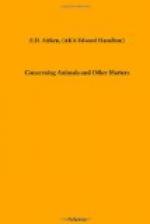Following this road you arrive at the seal and sea-lion. Of all the feet that I have looked at I know only one more utterly ridiculous than the twisted flipper on which the sea-lion props his great bulk in front, and that is the forked fly-flap which extends from the hinder parts of the same. How can it be worth any beast’s while to carry such an absurd apparatus with it just for the sake of getting out into the air sometimes and pushing itself about on the ice and being eaten by Polar bears? The porpoise has discarded one pair, turned the other into decent fins, and recovered a grace and power of motion in water which are not equalled by the greyhound on land. Why have the seals hung back? I believe I know the secret. It is the baby! No one knows where the porpoise and the whale cradle their newborn infants—it is so difficult to pry into the domestic ways of these sea-people—but evidently the seals cannot manage it, so they are forced to return to the land when the cares of maternity are on them.
I have called the feet of these sea beasts ridiculous things, and so they are as we see them; but strip off the skin, and lo! there appears a plain foot, with its five digits, each of several joints, tipped with claws—nowise essentially different, in short, from that with which the toad, or frog, first set out in a past too distant for our infirm imagination. Admiration itself is paralysed by a contrivance so simple, so transmutable, and so sufficient for every need that time and change could bring.
There remains yet one transformation which seems simple compared with some that I have noticed, but is more full of fate than they all; for by it the foot becomes a hand. This comes about by easy stages. The reason why one of a bird’s four toes is turned back is quite plain: trees are the proper home of birds, and they require feet that will grasp branches. So those beasts also that have taken to living in trees have got one toe detached more or less from the rest and arranged so that it can co-operate with them to catch hold of a thing. Then other changes quickly follow. For, in judging whether you have got hold of a thing and how much force you must put forth to keep hold of it, you are guided entirely by the pressure on the finger-points, and to gauge this pressure nicely the nerves must be refined and educated. In fact, the exercise itself, with the intent direction of the mind to the finger-points, brings about the refinement and education in accordance with Sandow’s principle of muscle culture.
For an example of the result do not look at the gross paw of any so-called anthropoid ape, gorilla, orang-outang, or chimpanzee, but study the gentle lemur. At the point of each digit is a broad elastic pad, plentifully supplied with delicate nerves, and the vital energy which has been directed into them appears to have been withdrawn from the growth of the claws, which have shrunk into fine nails just shielding the fleshy tips. In short, the lemur has a hand on each of its four limbs, and no feet at all. And as it goes about its cage—I am at the Zoo in spirit—with a silent wonder shining out of its great eyes, it examines things by feeling them with its hands.




